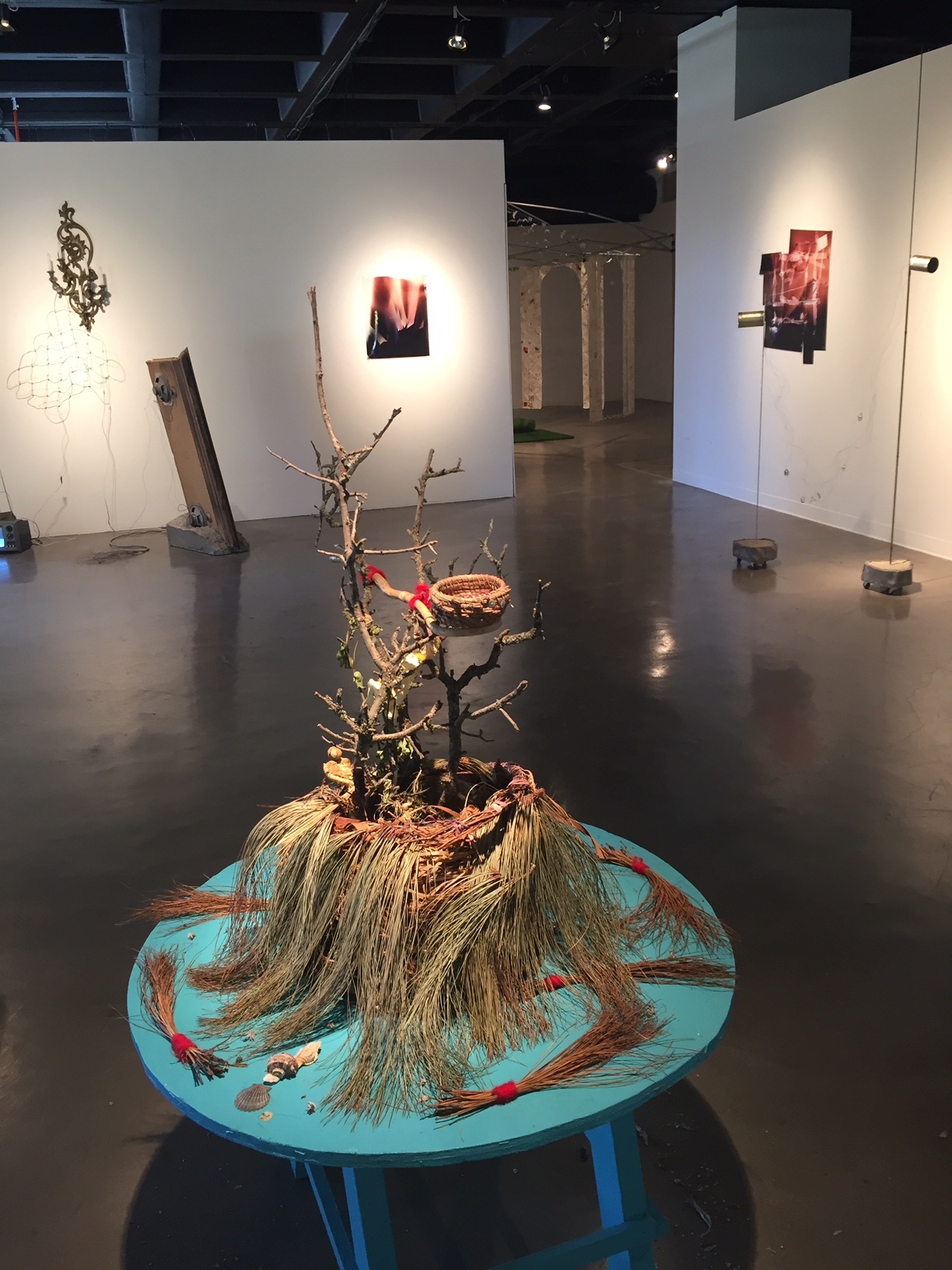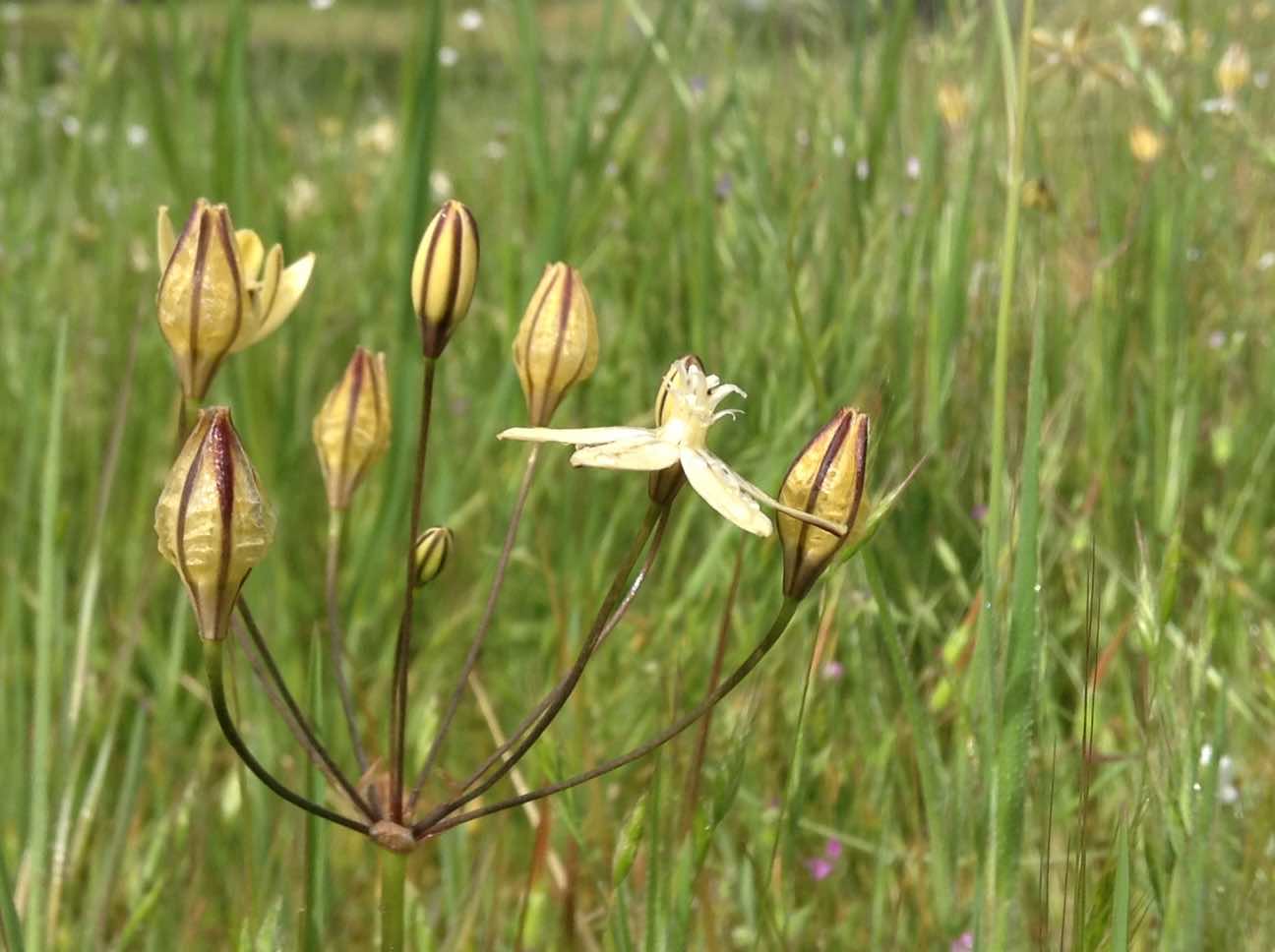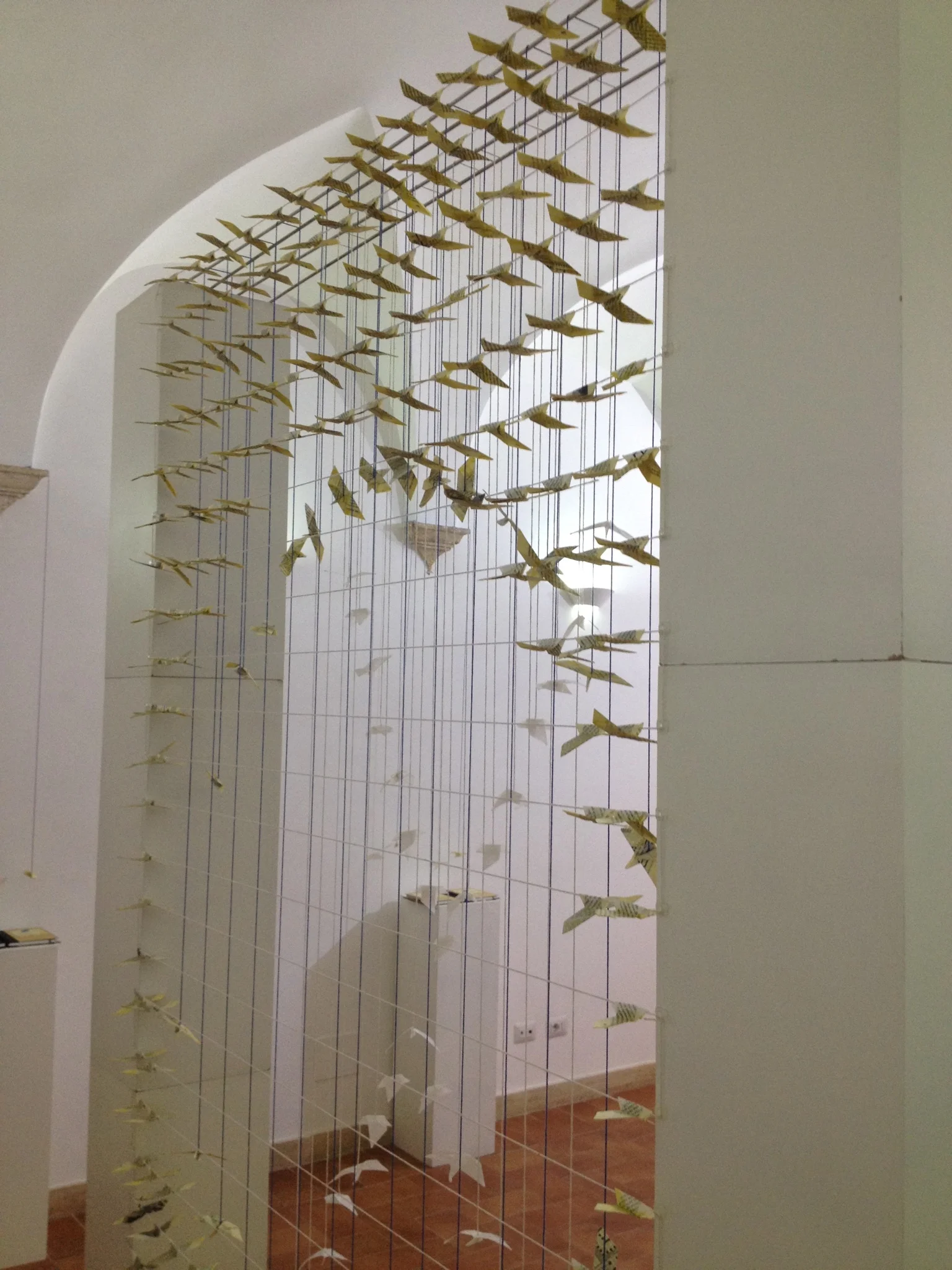Beyond the Pale
THURSDAY, March 7 – THURSDAY, APRIL 11, 2019
Opening Reception: Thursday, March 7, 6-8 pm, sponsored by Tacos El Unico
To go beyond the pale is to move outside the acceptable, the safe, and the known. Curated by Janet Owen Driggs, Beyond the Pale presents work by artists who step outside the bounds of Western scientific thinking in their efforts to know and interpret the world, including:
Johanna BREIDING & Shoghig HALAJIAN, Olivia CHUMACERO & Sarita DOUGHTERTY, Veronique d’ENTREMONT, Helen LESSICK, Jennifer MOON, and Louis PESCE.
Although the exhibition does include a near-magical broom, its title has nothing to do with buckets. Instead our “pale” refers to the “paling” fence posts that would once have enclosed a village or a fort, but which are now more commonly used to “impale” Hollywood vampires. MORE
Curator’s Essay
BEYOND THE PALE, by Janet Owen Driggs
Related Events
HELEN LESSICK & THE CYPRESS COLLEGE DANCE ENSEMBLE: Thursday, March 21 (Spring Equinox), noon-1pm
VERONIQUE D’ENTREMONT: Tuesday, March 26, 11.20 am-12.45 pm
“SPELLBOUND” and the VISUAL REPRESENTATION of WITCHES: Thursday April 4, 2.30-3.30pm
Artists
Johanna Breiding & Shoghig Halajian
The Rebel Body (Still), 2017
Digital C-Print
20" x 30"
Johanna Breiding & Shoghig Halajian
Evidence, 2017
Ink on paper
11 3/4 x 14 in.
Johanna Breiding & Shoghig Halajian
Johanna Breiding works with photography, video, installation and collaboration to reinterpret historical events, putting the past into a meaningful transformative relation with the present, and giving voice and ground to underrepresented and marginalized communities. Her practice is committed to representing subjects that are marked “deviant” or illegible, and to experiment with forms of world-making that offer an alternative to state-sanctioned legitimation, and gendered and racialized hierarchies. It invites viewers to feel how resistance might move our bodies and to activate the landscapes that hold us as we persist. In The Rebel Body (ongoing), made in collaboration with Shoghig Halajian, she explores ongoing strategies of political persecution through the story of Anna Göldi in Glarus, Switzerland, a woman who was victim to the 16th century European witch-hunts. This ongoing project will feature Marxist-Feminist writer Silvia Federici (Caliban and the Witch) and Glarus locals, who retell Anna Göldi’s story in order to activate the resilience of remembering and the landscape as a site of memory-keeping.
Shoghig Halajian's curatorial work and writings focus on queer and feminist histories, and explores visuality’s implications on the material conditions of bodies and on legislation. She often works collaboratively, and is invested in place-making projects that explore and propose models of collectivity. Her recent project, A grammar built with rocks (2018), co-curated with Suzy Halajian, began with research into the 1950's history of the Chavez Ravine evictions and explored the racialized erasure of people and place.
Johanna Breiding is a photographer, video and installation artist that archives queer narratives and underrepresented voices. Through collaboration, social realism and poetics Breiding depicts the importance of historical events, political movement and experiential pathos. She attended Scripps College, the Glasgow School of Art and received her Masters from CalArts. She has exhibited work at art venues and museums including Photo LA, LAXART, Human Resources Los Angeles, Ochi Projects, Elga Wimmer Gallery, the Armory Center for the Arts, Southern Exposure, the Berkeley Art Museum and Pacific Film Archive and the Oakland Museum of California. She is a recipient of the 2017 Rema Hort Mann Emerging Artist Grant, a 2011 DAAD Artist Grant and has attended numerous residencies including Summer Forum (2015) and Shandaken, Storm King Art Center (2018). Johanna Breiding currently lives and works in Los Angeles where she has been teaching at SFAI, CalArts, Cal State Fullerton and Scripps College over the recent years.
Shoghig Halajian is a curator and writer who serves on the Board of Directors at Human Resources LA. From 2013 to 2016, she was Assistant Director at LACE, where she curated numerous exhibitions. She has presented projects at the Hammer Museum, ONE Archives at the USC Libraries, and REDCAT, in Los Angeles; UKS, Oslo; Le Magasin-Centre National d’Art Contemporain, Grenoble, among other venues. She is currently a Ph.D. student in Art History, Theory, and Criticism at the University of California, San Diego, and a recipient of the 2017 Creative Capital I Andy Warhol Art Writers Grant for the forthcoming collaborative journal, Georgia.
Sarita Dougherty
Community Bloom: Ceanothus, Holly Oak, Matilija Poppy
Oil on board
46"W x 32"H x 2"
Olivia Chuacero
Still from When Light Married Water
Video, 2017
Olivia Chumacero & Sarita Dougherty
Olivia Chumacero and Sarita Dougherty collaborate in seasonal rhythms to establish relationships with California native plants found in both managed and uncultivated habitats in Southern California.
Our very existence as a species is the result of millions of years of causal relationships forged by sunlight, water, air and land. In Olivia Chumacero’s video entitled When Light Married Water, she juxtaposes the Southern California indigenous floral pallet with the inseparable relationship of the First Nation people, the Tongva, and their thousand–year practices of gathering and land management of said flora. Sarita’s oil paintings depict intimate details of color and community found amongst native California plants. After receiving offerings of songs and care, the flora would reveal layers of beauty, survival, pattern, and community, and the ways that such knowledges are available as medicine to human beings who generate relationships with them.
Nature is not an “other” outside of ourselves as the Western Landscape painting or Botanical Illustration cannon might suggest, but intrinsically connected to every aspect of our being. Sarita’s portraits illuminate the concept of relationship and resonance to guide our existence in ecosystem. The two collaborated on El Codice de Cambios, an illuminated manuscript that narrates their experiences creating relationship and uncovering layers of history at The Huntington Gardens, where they had a residency in 2017-2018. This map portrays plant medicine and fauna found at the site, a poem by Olivia Chumacero, and the lands' phases of ownership.
Olivia Chumacero speaks of our responsibility to the flora and the fauna of our home planet. Drawing from blood memory she teaches indigenous ways of reciprocity and reiterates, that we are not separate from nature but integral in nature and of nature. She teaches Everything is Medicine, which is a class, a community, a vision and a way of life. Everything is Medicine includes the healing gifts of our plant relatives, the way we greet each other on the street, and building kinship in the garden with plants, animals and other humans.
Join OLIVIA CHUMACERO and SARITA DOUGHERTY on the NATIVE SEEDS QUEST: Wednesday, March 13, 4 - 5:30 pm
Veronique d’Entremont
Reaction Formation, overview and detail. 2018
Television with electrical static, telephone cords, speaker cast in concrete, candelabra, candles, fire
Dimensions variable
Veronique d’Entremont
We Built This In The Dark, Then We Made Our Own Light, 2018
Photogram exposed by match light
33” x 37”/ 42” x 32”
Helen Lessick
Sweeper, 2018
Sculpture with ceiling-mounted motors and altered commercial brooms.
Engineering by Dave DeWitt
10’8” x 8’10” x 8’10.” moving parts
Jennifer Moon
A Breach in the Realm of Belief (Still), 2018
Video, color, sound, 20 min 57 sec
Jennifer Moon
3CE: A Relational Love Odyssey, 2015
Video, color, sound, 11 min 15 sec
Louis Pesce
V Formation, c.r.e.t.a. Rome
September 2014
Veronique d’Entremont
My grandmother sits on a couch in our wood-paneled basement, as she recounts the first time she was Slain in the Spirit. It’s like an orgasm from Jesus. My body went all limp-like, and I couldn’t move…I felt this warmth come over my body. She was on a religious retreat, alone in the Catholic chapel. I must have been making noise, because they came in and started slapping me! They sent her home, told her she needed to see a psychiatrist. Over nearly two decades we recorded dozens of conversations, sorting through a family history shaped by some combination of abuse, mental illness or curse. Do you want to see me speak in tongues? Turn off the camera. I am sixteen years old, and a skeptic, so I leave it on.
I am an interdisciplinary artist with reciprocal pedagogical, studio art and spiritual practices. My recent work serves as a tool for my own ancestral healing and learning from experiences of trauma and mental illness. I combine found materials culled from attics, basements, and recorded conversations, with processes that transform and reproduce information (casting, photography, rubbings). These unique objects seem to disrupt systems reproduction, and allegorically, of cultural and biological inheritance.
Overall, my work examines how we are shaped by, and can transform, the social and institutional spaces we inhabit-- from families of origin, to academic or correctional institutions. I consider domestic and institutional spaces to be sites of cultural reproduction and trauma formation, but potentially—or also--sites of liberation and recovery.
Veronique d’Entremont is a Los Angeles-based interdisciplinary artist, invested in collaborative practice, radical pedagogy and community organizing. She considers art and art-making to be tools for communication, self-reflection, and survival. In addition to her studio practice, Veronique co-founded the Liberated Arts Collective in 2016, and facilitates art projects with incarcerated and formerly incarcerated individuals.
Veronique received an MFA in Sculpture from UCLA in 2012, and her BFA in Art Education from Massachusetts College of Art in 2005, and has exhibited her artwork in Los Angeles, New York and Mexico City. Veronique has given lectures about her art and pedagogy work at UCLA, CalArts, Palomar College, New Mexico Highlands University, and at California Rehabilitation Center, a prison in Norco, CA. Veronique has received a Joan Mitchell MFA Grant (2012), a SPArt Grant (2016), and a Los Angeles Department of Cultural Affairs AIR Grant(2018) for her work.
Helen Lessick
How do you perceive the world? What is your engagement in our shared environment?
An artist of ideas, I investigate causes, conditions and poetics of common phenomena. An artist of situations, site and context inform my work. I apply creative lenses to public situations, striving to enhance a sense of place.
Harnessing curiosity to research, I work under-recognized forces with creative frames. Humble and little noticed topics, dust motes and breezes, the sweep of time and the history of science, when showcased with expanded perspective become moments of wonder.
Sweeper is one in a series of broom sculptures arising from my studio routine. While sweeping I wondered where this dust comes from and where dust goes. It led to questioning the nature of unseen routine and cycles of activity beyond the human hand. This led to motors and torque and sculpture uniting an engineer’s expertise and artist’s sense of play.
Kepler’s Dream, a site-and time-specific performance, explored the wonder of celestial change at my living tree sculpture planted in a Portland, Oregon arboretum. Inspired by Somnium, Johannes Kepler’s 1604 story, the two-day summer solstice spectacle repositioned a journey of observation and discovery. Through personas of a youth, crone, ship captain and administrator, I mirror Kepler’s parable of Duracotus.
Conceptual and playful, my work posits rigorous wonder in the quotidian. Perceiving the world as artist-explorer I report on uncharted territories beyond the pale.
Helen Lessick is an artist and creative catalyst. Her visual art is in collections of the Museum of Modern Art, Getty Research Institute, Sackner Archive for Conceptual and Concrete Poetry, and private and institution art collections. Her solo museum and gallery exhibitions have been seen across the United States. Her permanent public art is in Los Angeles, Seattle, Portland, and Nairobi, Kenya. A civic activist, Helen has lead public art projects in Houston, Inglewood, Los Angeles, New York and Seattle. She earned her BA from Reed College and MFA from UC Irvine. Originally from Philadelphia, Helen lives in Los Angeles.
Celebrate celestial rotation with HELEN LESSICK & THE CYPRESS COLLEGE DANCE ENSEMBLE for THE SWEEPER DANCE: Thursday, March 21 (Spring Equinox), noon-1pm
Jennifer Moon
My research and art interests investigate organizing systems of all kinds (social systems, institutional structures, power relations, scientific theories, emotional frameworks, etc.) and how these various systems are inscribed and transmitted through bodies (human, nonhuman, material, immaterial). Drawing from queer life, science, self-help, popular culture, the extremely personal, and fantasy, my work considers the potential of intra-action[1] amid these interlocking systems to reignite the social and political imaginary and to stimulate change.
As an artist, my practice can be understood to follow the lineage of life-artists from early conceptualism, such as "Lee Lozano, Stephen Kaltenbach, Linda Montano, and David Hammons, among others” (Catherine Wagley, “Moon, laub, and Love,” CARLA). As with these artists, my life becomes my art and it is unclear where the boundary of my art begins and my life ends. Alternately, it is through art that I am able to adventure into difficult topics in order to learn more about life. I am interested in blurring these artificial boundaries, exposing them so I may investigate our complex relationship to borders. It is my belief that the segregation of the personal and the political, the public and the private, the individual and the populace are no longer expansive. I am committed to dismantling all the macro and micro systems that keep us separate from one another, locked in a binary and hierarchized, where capital becomes our primary point of connection.
Within realities constructed by normative modes of representation, Jennifer Moon is a Los Angeles based artist, writer, adventurer, and revolutionary with the appropriate qualifying degrees. Within realities of the impossible, the unknown, and the unimaginable, Jennifer Moon is an android-like humanoid creature from the quantum realms of dark matter and dark energy committed to understanding human emotions and creating alternatives to the predetermined outcomes of art and of life. Drawing from the extremely personal, blending a mix of queer life, science, self-help, popular culture, and fantasy, Moon presents possibilities of futures and ways of being beyond binaries, hierarchies, and capital that keep us locked in a 5% universe.
[1] Intra-action is a neologism offered by feminist physicist Karen Barad as part of her theory of agential realism, which acknowledges our reality as co- constitutive—emerging from the entanglement of bodies, material-discursive practices, and apparatuses. Interactions assume that individuals, objects, and phenomena preexist their entanglements.
Jennifer Moon will discuss her work at the Gallery on Wednesday, March 27, 2-3 pm
Louis Pesce
An auspicious omen occurred in 2005 when I observed a flock of birds circling in the sky above the ruins of ancient temples in the center of Rome, Italy. As a result, I not only began to investigate the historical developments of Roman temples but also initiated a daily ritual of folding paper squares into the shape of birds.
My contemplative practice has since evolved into structures built from the bird forms that demarcate sacred spaces. Each paper temple construction draws upon multiple planes of reference that include personal narratives, architectural geometries, metaphoric meanings, Roman mythologies and Latin etymologies.
The word contemplate (to gaze, reflect and consider) is based on templum (the Latin origin of temple), which means to mark out a sacred place for observation. Ancient augurs (a college of Roman priests) would consecrate a templum in a rectangular area of land and sky to observe the flight of birds and interpret auspicious omens. The etymology of auspicious (a good omen) is derived from the Latin auspex with the roots: awi (bird) and spek (to observe).
Temple of Contemplation, my 2019 installation at Cypress College, allows one person at a time inside the structure to make their own observations and interpretations, as the Roman augurs once did in antiquity.
Before migrating in 2007 from the East Coast to Southern California, Louis Pesce received both a Bachelor of Fine Arts degree from Tufts University affiliated with the School of the Museum of Fine Arts in Boston, and a Master of Landscape Architecture degree from University of Florida in Gainesville. For the last decade, he has worked as a full-time team member with Lauren Bon and the Metabolic Studio in downtown Los Angeles. As artist-in-residence in the autumn of 2014, Louis created a mixed media installation, V Formation, for a solo exhibition at the c.r.e.t.a. gallery in the center of Rome, Italy.


